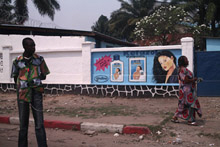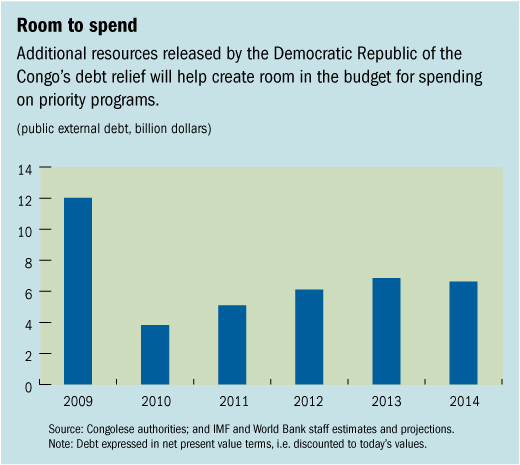
Typical street scene in Santa Ana, El Salvador. (Photo: iStock)
IMF Survey: IMF, World Bank Support $12.3 Billion Debt Relief for DR Congo
July 1, 2010
- Relief cuts Democratic Republic of the Congo's debt by more than 80 percent
- Deal highlights authorities' progress in policy management, performance
- IMF urges authorities to stay on course on economic reforms
The IMF and the World Bank decided June 30 and July 1, respectively, to support debt relief worth $12.3 billion for the Democratic Republic of the Congo.

Billboard in Kinshasa, Democratic Republic of the Congo, where debt relief could help improve prospects for private investment (photo: Newscom)
DEBT RELIEF FOR AFRICA
The decision grants the debt relief under the Heavily Indebted Poor Countries Initiative (HIPC). Having reached the HIPC Initiative’s final stage, or completion point, the Democratic Republic of the Congo also qualifies for debt relief under the Multilateral Debt Relief Initiative (MDRI).
“Reaching the HIPC completion point demonstrates the significant progress that the authorities have made over the past several years in strengthening macroeconomic policy management and performance following a decade-long devastating conflict that destroyed the country’s economic and social infrastructure,” said the IMF’s mission chief for the Democratic Republic of the Congo, Brian Ames.
“The conditions for reaching the HIPC completion point provided the authorities with a policy and reform framework that guided their efforts to enhance macroeconomic stability, address weaknesses in public financial management and economic governance, and reform the social sectors. Progress in each of these areas also sets a solid foundation for advancing the country’s development agenda going forward,” he added
The decision of the IMF and World Bank Executive Boards will generate total debt service savings of $12.3 billion in debt relief ($7.9 billion in present value terms—the discounted sum of all future debt service obligations) of which $11.1 billion is under the enhanced HIPC Initiative and $1.2 billion is under the MDRI. Debt relief from the IMF totals $491 million and from the International Development Agency $1.8 billion, with the remainder expected to come from official and commercial creditors.
The additional resources released by the debt relief will help create room in the budget for spending on priority programs such as roads, schools, and hospitals (see chart). The significant reduction in the country’s debt burden also will help improve prospects for private investment.

From conflict to reconstruction
The Democratic Republic of the Congo remains one the poorest countries in Africa notwithstanding the country’s immense natural resources. Economic mismanagement and a decade-long conflict have destroyed the country’s social and economic infrastructure and limited its progress toward achieving the United Nations Millennium Development Goals.
Since 2001, the country has made significant progress in political and economic reform. National reconciliation efforts led to the end of a decade-long conflict and the establishment of a transitional government in 2003 that eventually led to the first democratically elected government in four decades in 2006. On the economic front, prudent macroeconomic policies and critical structural reforms helped restore confidence, reestablished economic growth, and tamed hyperinflation.
In December 2009, the IMF Executive Board approved a three-year arrangement under the Extended Credit Facility (ECF) equivalent to $551 million to support the authorities’ economic reform program. Satisfactory implementation of the ECF-supported program, along with implementation of a set of measures defined at the HIPC interim stage, or decision point were the prerequisites for reaching the completion point under the HIPC Initiative and debt relief under the MDRI.
Strong reform effort
Despite the global financial crisis, the DRC continued on the road of economic development and reconstruction guided by its ECF-supported program. In 2009, steep declines in export prices and the slowdown in external demand curbed economic growth while inflation rose significantly following a sharp depreciation of the Congolese franc vis-a-vis the U.S. dollar. However, the DRC authorities persevered and continued to implement prudent macroeconomic policies and advance structural reforms over the past 12 months.
Good revenue performance and expenditure restraint--supported by reforms in revenue management and public financial management—contained fiscal imbalances and curtailed government recourse to central bank financing. This together with tight monetary policy reduced pressures on the exchange rate and inflation.
An increase in the share of investment in overall government spending helped mitigated the impact of the global financial crisis on domestic demand. In this context, economic growth is estimated at 2.8 percent in 2009, down from 6.2 percent in 2010.
In addition to satisfactory macroeconomic performance under the ECF-supported program, the authorities met all other conditions for the HIPC completion point by accelerating reforms in the social sectors, economic governance, and debt management.
Long road to recovery
Despite progress over the past several years, the Democratic Republic of the Congo faces significant development challenges. Although the debt relief will free up resources for priority spending, especially human capital formation, more needs to be done to make progress toward the Millennium Development Goals.
• Consolidating macroeconomic stability. The authorities need to maintain fiscal discipline to avoid re-emergence of financing fiscal deficits with money creation—the source of macroeconomic instability in the past. Among other things, this will require strengthening domestic revenue mobilization and establishing rule-based public financial management. Strengthening central bank independence, including through its recapitalization, is also essential for effective monetary policy that keeps inflation in check.
• Pro-poor and pro-growth budgets. The authorities need to improve the quality of government spending. In line with objectives of the authorities’ poverty reduction and growth strategy, the focus should be the reconstruction of the country’s physical infrastructure—such as roads and railroads—and the rebuilding of its human capital.
• Improving the business climate. Reforms to improve the economy’s supply response are critical for strengthening economic growth and reducing poverty. The authorities need to advance the ongoing reform of public enterprises, especially those that provide growth-critical services. There is also an urgent need for the authorities to improve governance and the business climate, including through enhancing property rights protection by harmonizing regulations with the protocol of the Organization for the Harmonization of African Business Law and adhering to the Extractive Industries Transparency Initiative.







